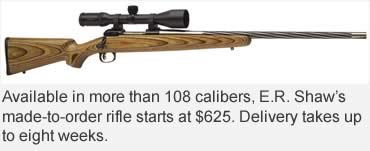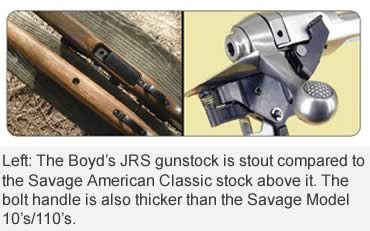The E.R. Shaw Mark-VII rifle has the options of a custom gun at a working man’s price.
Lofty observations are common in articles on custom hunting guns. Shooting writers rave over fancy walnut, fine-line checkering, scroll engraving and other touches that you, the discriminating buyer, can add to make the firearm truly one of a kind. What’s usually not mentioned until later in the story — usually much later — is the fancy gun’s price.
Custom guns are nice, but they’re simply not practical for a lot of working-class hunters. What we proletarians could use is a rifle with custom options at a factory rifle price.
In 2007, E.R. Shaw, America’s oldest independent manufacturer of gun barrels, recognized that niche and began producing its Mark-VII bolt-action rifle. Essentially, it’s a custom, made-to-order barreled action with an aftermarket stock, yet its price starts at $625 for the basic model.
That is not a misprint.
Made in the company’s Bridgeville, Pa., custom shop, the rifle is offered in more than 108 calibers, both standard and wildcat. Right- and left-hand barreled actions are available, in stainless steel and blued chrome-moly. Four different barrel contours are offered as well.
Not even the custom shops of America’s largest gunmakers list that many barrel options. Barrel lengths run from 16.25 to 26 inches. Also on the menu is straight or helical fluting, which looks great, reduces barrel weight and speeds cooling. E.R. Shaw is the only source for the helical fluting, for which it holds two patents.
Drop-in stocks from Boyd’s Gunstocks include walnut, composite and wood laminates. But customers aren’t limited to these stocks. You can order a barreled action and drop it into the inletted stock of your choice.
E.R. Shaw was formed in 1975 by Small Arms Inc., a major supplier of gun barrels to the sporting arms industry. The parent company started in 1913 as a defense contractor providing .30-caliber barrels to American troops in WWI.
In the mid 1950s, Small Arms began selling barrels to individuals and the gunsmithing trade. Rifled blanks to barrels ready for installation could be ordered. Business was brisk, and soon the company was fitting as many as 2,500 barrels a month in addition to its mail-order sales.
 Ed Shaw purchased Small Arms Inc. in 1975 and established E.R. Shaw as a separate mail-order division. The decision proved to be a wise one because both companies have prospered. Last year, E.R. Shaw introduced the Mark-VII bolt-action rifle under a new division, Shaw Precision Rifles.
Ed Shaw purchased Small Arms Inc. in 1975 and established E.R. Shaw as a separate mail-order division. The decision proved to be a wise one because both companies have prospered. Last year, E.R. Shaw introduced the Mark-VII bolt-action rifle under a new division, Shaw Precision Rifles.
Recent investments in CNC equipment and other upgrades have made E.R. Shaw one of the most advanced barrel companies in the U.S., producing barrels in 416 stainless and chrome-moly.
Rather than make its own action, which would inflate the gun’s price, E.R. Shaw, through a licensing agreement with Savage Arms, starts with a slightly modified version of a Savage Model 10/110 action. The bolt handle is slightly different from the 110’s, and there’s a quarter-inch recoil lug instead of a lock ring. However, in most other respects, the action is the same.
The bolt has dual-locking lugs, a recessed bolt face and a plunger-type ejector.
Also standard on the ERS rifle is the Savage Accu-Trigger, which the user can safely adjust from 1.5 to 6 pounds. There’s a two-position safety on the tang.
When I saw the list of caliber options for the Mark-VII, I had to order one for myself. Standard chamberings run from .17 Rem to .458 Lott. Wildcats include .20 Vartarg; .224 Texas Trophy Hunter; .6.5-06, .257 Roberts Ackley Improved, .30-338 and others.
I’m a longtime fan of .25 calibers for whitetail hunting. They get the job done without a lot of recoil, which makes them more accurate in the hands of most hunters. The choice came down to the .25-06 Ackley Improved and the short-action .25-284. I decided on the.25-284 with a varmint-weight (4-pound, 3-ounce) barrel.
The .25-284 sends bullets downrange as fast as the .25-06, but has several advantages over the factory round. The sharper shoulder extends case life, and the shorter powder column burns powder more efficiently. If this sounds like a short magnum, it’s because it is one. The parent .284 Winchester, introduced in 1963, was the original short mag.
Brass is most easily created by necking down Norma’s 6.5-.284 case in one pass, but it’s also possible to resize .284 Win brass. Norma standardized the 6.5-.284 in 1999, so finding brass is no problem.
 Redding, RCBS and Hornady offer .25-284 dies. I elected to use Norma brass and a three-die set from Redding. Neck-sizing cases instead of running them through a full-length resizing die further extends case life.
Redding, RCBS and Hornady offer .25-284 dies. I elected to use Norma brass and a three-die set from Redding. Neck-sizing cases instead of running them through a full-length resizing die further extends case life.
With a Swarovski 3-12x50mm scope aboard, the gun weighed 10 pounds even, largely due to its varmint-weight barrel. The nutmeg-colored laminate stock is the JRS Classic model from Boyd’s. Price for a rifle identical to mine is $800.
The deadline for this article came and passed before I could work up the most accurate handload for the gun. But the third load I tried punched a 1 1/4-inch three-shot group at 100 yards. A lot of people would be happy with that, but I expect to have the rifle dialed in by the time the deer season rolls around. This is one custom that will get used, not just displayed on a wall or in a gun cabinet.
Editor’s Note: Mark VII rifle prices have risen since this article originally appeared in 2008. The current price range is $775 to $1,200. The company also has an online gun builder that adds options in five steps and lets you see and compare the results. www.ershawbarrels.com
This article was published in the December 2008 edition of Buckmasters GunHunter Magazine. Subscribe today to have GunHunter delivered to your home.